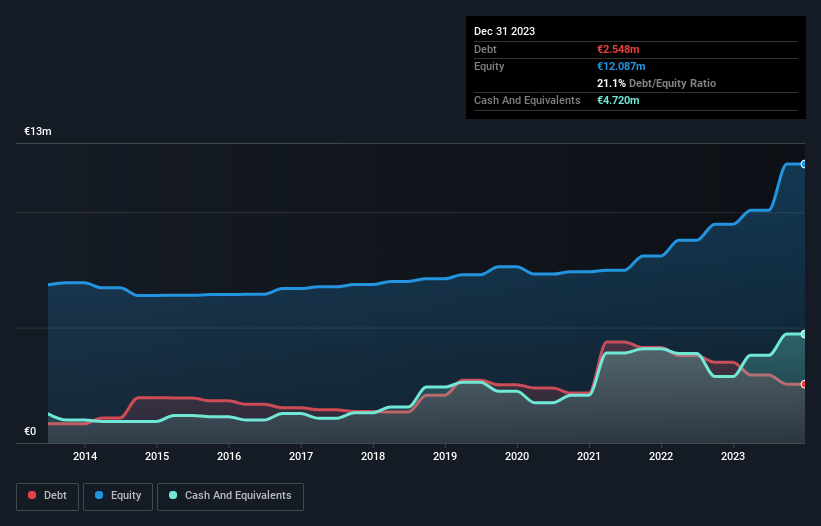Some say volatility, rather than debt, is the best way to think about risk as an investor, but Warren Buffett famously said that 'Volatility is far from synonymous with risk.' When we think about how risky a company is, we always like to look at its use of debt, since debt overload can lead to ruin. We can see that Plan Optik AG (ETR:P4O) does use debt in its business. But is this debt a concern to shareholders?
Why Does Debt Bring Risk?
Generally speaking, debt only becomes a real problem when a company can't easily pay it off, either by raising capital or with its own cash flow. If things get really bad, the lenders can take control of the business. However, a more frequent (but still costly) occurrence is where a company must issue shares at bargain-basement prices, permanently diluting shareholders, just to shore up its balance sheet. By replacing dilution, though, debt can be an extremely good tool for businesses that need capital to invest in growth at high rates of return. When we examine debt levels, we first consider both cash and debt levels, together.
Check out our latest analysis for Plan Optik
How Much Debt Does Plan Optik Carry?
You can click the graphic below for the historical numbers, but it shows that Plan Optik had €2.55m of debt in December 2023, down from €3.50m, one year before. But on the other hand it also has €4.72m in cash, leading to a €2.17m net cash position.

How Strong Is Plan Optik's Balance Sheet?
We can see from the most recent balance sheet that Plan Optik had liabilities of €2.28m falling due within a year, and liabilities of €1.85m due beyond that. Offsetting these obligations, it had cash of €4.72m as well as receivables valued at €574.6k due within 12 months. So it can boast €1.17m more liquid assets than total liabilities.
This short term liquidity is a sign that Plan Optik could probably pay off its debt with ease, as its balance sheet is far from stretched. Simply put, the fact that Plan Optik has more cash than debt is arguably a good indication that it can manage its debt safely.
Also good is that Plan Optik grew its EBIT at 17% over the last year, further increasing its ability to manage debt. When analysing debt levels, the balance sheet is the obvious place to start. But it is Plan Optik's earnings that will influence how the balance sheet holds up in the future. So when considering debt, it's definitely worth looking at the earnings trend. Click here for an interactive snapshot.
Finally, a business needs free cash flow to pay off debt; accounting profits just don't cut it. Plan Optik may have net cash on the balance sheet, but it is still interesting to look at how well the business converts its earnings before interest and tax (EBIT) to free cash flow, because that will influence both its need for, and its capacity to manage debt. Looking at the most recent three years, Plan Optik recorded free cash flow of 24% of its EBIT, which is weaker than we'd expect. That's not great, when it comes to paying down debt.
Summing Up
While it is always sensible to investigate a company's debt, in this case Plan Optik has €2.17m in net cash and a decent-looking balance sheet. And we liked the look of last year's 17% year-on-year EBIT growth. So we don't think Plan Optik's use of debt is risky. There's no doubt that we learn most about debt from the balance sheet. But ultimately, every company can contain risks that exist outside of the balance sheet. Be aware that Plan Optik is showing 2 warning signs in our investment analysis , you should know about...
If, after all that, you're more interested in a fast growing company with a rock-solid balance sheet, then check out our list of net cash growth stocks without delay.
New: Manage All Your Stock Portfolios in One Place
We've created the ultimate portfolio companion for stock investors, and it's free.
• Connect an unlimited number of Portfolios and see your total in one currency
• Be alerted to new Warning Signs or Risks via email or mobile
• Track the Fair Value of your stocks
Have feedback on this article? Concerned about the content? Get in touch with us directly. Alternatively, email editorial-team (at) simplywallst.com.
This article by Simply Wall St is general in nature. We provide commentary based on historical data and analyst forecasts only using an unbiased methodology and our articles are not intended to be financial advice. It does not constitute a recommendation to buy or sell any stock, and does not take account of your objectives, or your financial situation. We aim to bring you long-term focused analysis driven by fundamental data. Note that our analysis may not factor in the latest price-sensitive company announcements or qualitative material. Simply Wall St has no position in any stocks mentioned.
About XTRA:P4O
Flawless balance sheet with questionable track record.
Market Insights
Community Narratives



